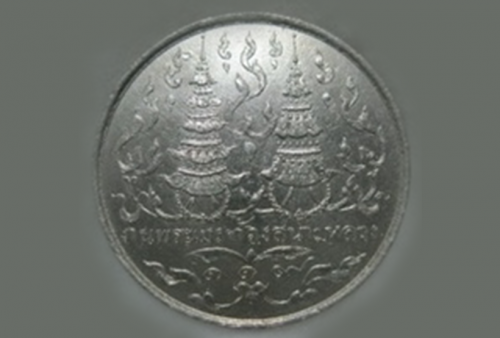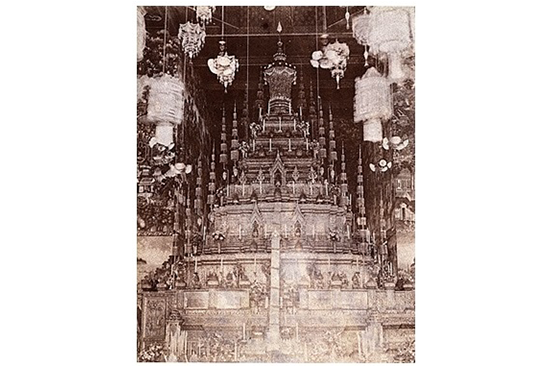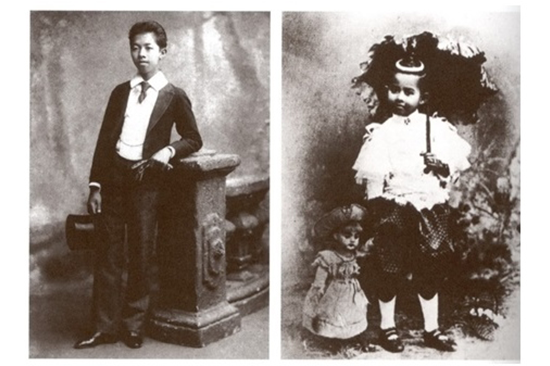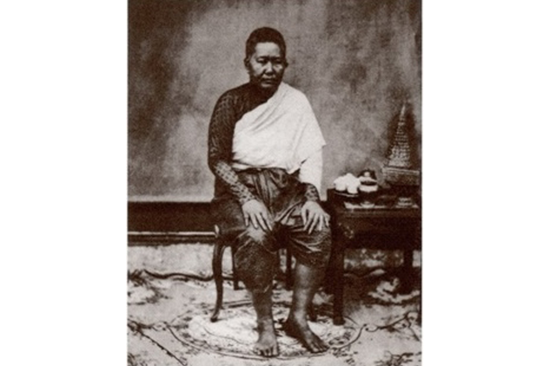Mint Coins in Commemoration of the Royal Pyre Ceremony at the Royal Ground in the year 119 of the Rattanakosin Era
Thai royal traditions give the utmost importance and reverence to the royal institution. The royal family are regarded as demi-gods. Upon their death, a large construction of a cremation site which is exquisitely adorned with ceremonial decorations is constructed. This occasion is called the Royal Pyre Ceremony or Gnan Ok Phra Meru which has continued since the Ayutthaya period. Later in the reign of King Chulalongkorn, five royal funerals were held during the same period, across the year 1900. On this occasion, the King commissioned commemorative coins in memory of the Royal Pyre Ceremony at the Royal Grounds in the year 119 of the Rattanakosin Era to be made in order to record this particular event. The coins were made in several kinds of metal, including gold-plated silver coins, silver coins, silver-plated copper coins, and copper coins.
The Royal Pyre Ceremony during pre-Rattanakosin period
The royal pyre or Phra Men is a temporary pyre built for the cremation of the members of the ruling class, for example, the king and the members of the royal family. There is evidence of the building of royal pyres since the Ayutthaya period. There has been no mention of Phra Men in the Sukhothai period; however, the oldest evidence that mentions a royal funeral is Triphum Khata or Traiphum Phra Ruang, the first Buddhist literature to have ever existed in Thailand, which was composed by King Thamma Racha I or Phaya Lithai of Sukhothai during year of the rabbit in 1345 AD. There is a description of the royal procedure carried out on the royal body of King Maha Chakrapadiratch:
"At that time, [the body of] Phra Chakrapadiratch was anointed with fragrant wood powder, then bound with a layer of fine white shroud, and a layer of fine cotton wool. The cerement is a thousand layers in total, namely five hundreds layers of shroud and five hundreds of cotton wools. [The body] was sprinkled with perfume which had been processed a hundred times, then placed in a gold urn-shaped casket that was beautifully adorned with precious stones and exquisite decorations. The body was then carried away to be cremated with sandal wood. Roasted rice and flowers were also given as a sign of respect. When the cremation was finished, people collected the ashes of Phraya Maha Chakrapadirach, and built a Chedi to house the ashes so that people can pay their respect.”
In the Ayutthaya period, the first recorded evidence regarding a building of a royal pyre was mentioned in the royal archives and annals from the mid-Ayutthaya period. There was a description of the royal pyre built for King Naresuan during the royal funeral which was held during King Ekatosarod’s reign:
"The royal funeral pyre was 1 Sen in height and 17 Wa in length, adorned with decorative pyres, which were placed in four directions and in lines, along with decorative fences, golden multi-tiered umbrellas, Naga multi-tiered umbrellas, and five-coloured multi-tiered umbrellas. When the decorations were complete, the royal body was placed on a throne which was lavishly adorned with royal umbrellas. Then, the nobles came and gathered around the throne to move the royal body to the pyre via a path decorated by royal umbrellas and flags. In the procession were also plenty of servants and oblations”
Existing evidence suggests that the only royal funeral of a high-ranking royalty held in the Thonburi period was that of Grom Phra Thephamas, the mother of King Taksin. The archive only mentions the building of the pyre and the procession of the royal ashes, both of which were held very briefly. It can be understood that the funeral occurred during the time of war, thus it was not a great period of time to hold such ceremonies in full accordance to ancient traditions.
The Royal Pyre Ceremony during the early-Rattanakosin period
In the Rattanakosin period, from the reign of Phra Phutthayotfa Chulaloke (Rama I) to that of King Phra Chom Klao (Rama IV), the building of the royal pyres strictly followed the Ayutthaya tradition to almost every detail. The pyres were made in a gold colour and to a very large size, for the purpose of honouring royal glory. Later during the reign of King Rama V, the King reflected that, according to tradition, large pyres should be built on Royal Grounds in order for the royal fire to be placed; however, doing so would require large amount of manpower and resources, causing great difficulty to the people, and costing a great deal of money. What is more, a pyre was made only for a single use and would have to be disassembled after the ceremony. Upon this reflection, the traditional procedure regarding the royal funeral pyre, which had been passed on since Ayutthaya period, came to an end after the royal funeral of King Rama IV.
Sanumluang in the Past
The place where the royal cremation of Kings and members of the royal family took place is called Thung Phra Men, which literally means the Royal Pyre Ground. In 1855, King Rama IV ordered that the name was changed from Thung Phra Men to Sanam Luang which means the Royal Ground. It was stated in a royal announcement that "The field in the front of Mahathat Temple was called Thung Phra Men, after a misfortunate occasion which only happens once in a while. That is not appropriate. From now on, this field in front of Mahathat temple is ordered to be called Sanam Luang.” Later during King Rama V’s reign, the King ordered an expansion of this field to be used for various royal occasions.
Royal Funeral at the Royal Grounds in the year 119 of the Rattanakosin Era
During the period of King Rama V, five royal funerals as well as royal cremations were held for five members of the royal family between January and February of 1900. These occasions were considered a great royal funeral ceremony held on the Royal Grounds. This was due to the fact that several royalties had died, but had not been given a cremation ceremony according to their ranks, until the year 1900 when it was an appropriate time to arrange the royal cremation for all royals. The deceased royals who were to receive royal cremation ceremonies at this occasion included the Crown Prince Maha Vajirunhis, Prince Sommutiwongse Warothai, Princess Siraphon Sophon, Princess Sudarat Ratchaprayoon, and Prince Chaturon Rasmi. The King commissioned Prince Phittayalap Phluetthada to arrange the funerals to be held separately because the deceased royals held different ranks, the details of which will be explained further.
Each deceased royalty were high-ranking members of the royal family who had a very close relationship with King Chulalongkorn. The ceremonies were held differently according to the ranks of the royalty. The details are as followed:
1. Royal funeral of Crown Prince Maha Vajirunhis.
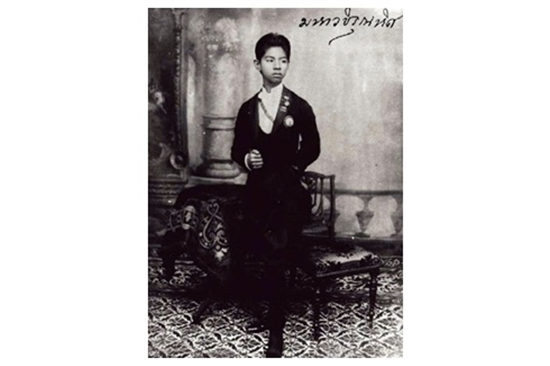
Crown Prince Maha Vajirunhis
Prince Maha Vajirunhis was the first son of King Chulalongkorn and Queen Savang Vadhana, born on Thursday, the 12th waning moon day of 7th lunar month, in the year of the tiger 1240 Minor Era, or 27th of June 1878. He was the first to have been given the title of the Crowd Prince of Thailand in 1248 Minor Era (1886 AD). This title is the title of the royal heir which replaced the title of Vice King or Grom Phra Ratchawang Bowornsathan Mongkhol or Wang Na, which had continued from the Ayutthaya period. The crown prince fell ill and died on 4th of January 1894, at the age of 17 years old.
Golden Urn for Crown Prince Maha Vajirunhis in the Royal Funeral Fall
The Crown Prince Maha Vajirunhis held the rank that was equal to the Vice King. The setting of the royal body included a gold urn-shaped casket, with a tapering lotus-shaped tip, decorated with chain festoons and crafted flowers on wire. In the royal funeral hall at Wat Bowornsathan Suthawas, the casket was placed on a five-tiered pedestal, decorated with glass, under the shelter of a seven-tiered royal umbrella which was also decorated with numerous regalia, sunshades, and three-tiered umbrellas according to the Crown Prince’s rank. On the 24th of January 1900, which was the next day, there was a royal cremation with a royal fire on the Royal Grounds. After the cremation, the King collected the remains in a coloured-glazed gold urn which was initially kept in the Royal Funeral Hall, until it was later moved and stored in a hall, in Chakri Maha Prasat Throne Hall at the Royal Palace. The ashes were put in a cylinder case and kept at Wat Ratchabophit. This marked the completion of the royal funeral of the Crown Prince Maha Vajirunhis.
2. Royal funeral of the Prince Sommutiwongse Warothai.
Prince Sommutiwongse Warothai was a son of King Chulalongkorn and Queen Savang Vadhana, born on Friday, the 8th waning moon of 7th lunar month, in the year of the horse, 1244 Minor Era, or 9th of June 1882 AD. The Prince died on Saturday, the 10th waxing moon day of the 8th lunar month, in the year of the Pig, 1261 Minor Era, or 17th of June 1899 AD, at the age of 18 years old.
Prince Sommutiwongse (Left) and Princess Siraphon Sophon (Right)
The setting of the royal body of Prince Sommutiwongse Warothai included a gold urn-shaped casket, with a tapering lotus-shaped tip, decorated with chain festoons and crafted flowers on wire. The casket was placed on the Maha Phichai carriage which moved the body to the funeral hall. There, Prince Sommutiwongse was placed alongside Princess Siraphon Sophon on a five-tiered pedestal, under gold-painted five-tiered umbrellas, decorated with high regalia. The cremation took place at the royal pyre at the Royal Ground on 24th of January 1900.
3. Royal funeral of Princess Siraphon Sophon.
Princess Siraphon Sophon was a daughter of King Chulalongkorn and Queen Savang Vadhana, born on Thursday, 11th waxing moon day of the 8th lunar month, in the year of the Mouse, 1250 Minor Era, or 19th of July 1888 AD. The princess died on Saturday, the 9th waxing moon day of the 7th lunar month, in the year of the Dog, 1260 Minor Era, or 28th of May, 1898 AD, at the age of 9 years and 10 months.
The setting of the royal body of Princess Siraphon Sophon included an adorned, gold plated wooden urn-shaped casket which was placed on the Vechayantra carriage and moved to the funeral hall. At the funeral hall, the casket was placed on a five-tiered pedestal, under gold-painted five-tiered umbrellas, decorated with high regalia. The cremation took place at the royal pyre in the Royal Grounds on 28th of January 1900. Prince Sommutiwongse Warothai and Princess Siraphon Sophon both were half siblings of Crown Prince Maha Vajirunhis, who also died about the same time.
4. Royal funeral of Prince Chaturon Rasmi.
Prince Chaturon Rasmi Krom Phra Chakrapadipongse was a son of King Chom Klao
(King Rama IV) and Queen Sirintra, born on Tuesday, the 3rd day of the 2nd lunar month, in the year of the dragon, 1218 Minor Era, or 14th of January 1868. The Prince was given the title of Chaofa Chaturon Rasmi Srisommutthewarachrawiwongse Warophaiphongphisut Makhutratchawarangkul Mahaisuryaharatcha Kumar. On Friday, the 11th waning moon of 2nd lunar month, in the year of the pig, 1237 Minor Era, or 21st of January 1875, and the prince was promoted to Chaofa Chaturon Rasmi Srisommutthewarachrawiwongse Warophaiphongphisut Makhutratchawarangkul Mahaisurya Haratchanarin Thranuchathibodi Krom Luang Chakrapadipongse. His Highness had served as the second chief to the Royal Treasury. On Friday, the 11th waxing moon of 2nd lunar month, in the year of the chicken, 1247 Minor Era, or 1885, the Prince were promoted to the title Chaofa Chaturon Rasmi Krom Phra Chakrapadipongse Damrongkhutiyesak Akruanyot Rattanasommut Burisachanai Sidolharuethaithammasucharit Anekratchakijsithivijarn Maholarnkunasombat Phutathiratsoranakhom Udomdechanuphabbophit. His Royal Highness served as the Chief of the Royal Treasury. Prince Chaturon Rasmi died on Wednesday, 12th waxing moon of the 5th lunar month in 1262 Minor Era, or 12th of April 1900, at the age of 43 years and 2 months.
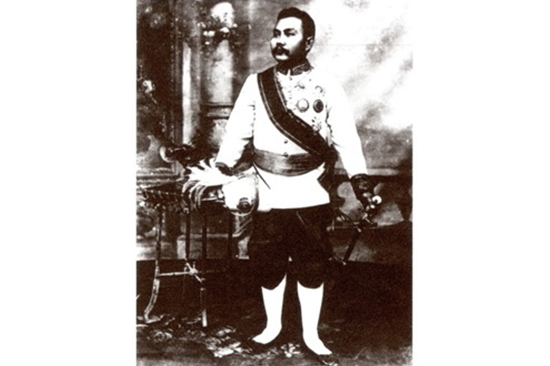
Prince Chaturon Rasmi
The setting of the royal body of Prince Chaturon Rasmi included a gold plated wooden urn-shaped casket with a tapering lotus-shaped tip, decorated with chain festoons, crafted flowers on wire, high umbrellas and high regalia. The casket was moved from its first place by Ekachai royal yacht across the Chao Phraya River. The royal yacht docked at Atsadang Road where the casket was transferred to Vetchayanta carriage in front of Wat Chetuphon Wimonmanklaram. The casket was paraded to the royal pyre at Wat Bowornsathan Suthawas. At the funeral hall, it was placed on a five-tiered pedestal under gold-painted seven-tiered umbrellas decorated with high regalia according to the rank of the late-prince, with deity figures holding the regalia. The royal cremation was arranged later at the royal pyre in the Royal Grounds on the 1st of February 1900.
Princess Sudaratana Ratchaprayoon
5. Princess Sudaratana Ratchaprayoon or Phra Ong Chao Lamom is the daughter of King Nangklao and the royal consort Chao Chom Manda Sap, born on Tuesday, the 11th waxing moon day of the 1st lunar month, in the year of the tiger, or the 8th of December 1818. King Rama V bestowed the princess the title of Phrachao Ratchawongter Kromphra Sudaratana Ratchaprayoon on Friday, the 5th waxing moon of the 2th lunar month, in the year of the Dragon, 1230 Minor Era, or the 18th of December 1868. The princess was promoted to Phra Borommahayikater Krom Somdet Phra Sudaratanaratchaprayoon on Thursday, the 14th waxing moon day of the 2nd lunar month, in the year of the Chicken, 1235 Minor Era, or the 1st of January 1873. The promotion was due to the fact that the princess was also born to the mother of King Chulalongkorns’ great grandfather, and that the princess had helped raise the King, when he was young, and served as a female officer of the court during the reign of the King. Princess Sudaratana died on Monday, the 9th waxing moon of the 9th lunar month, in the year of the monkey, 2158 Minor Era, or the 17th of August 1896.
The setting of the royal body of Princess Sudaratana included a gold urn-shaped casket, with a tapering lotus-shaped tip, decorated with chain festoons, crafted flowers on wire, and seven-tiered gold-painted umbrella. The casket was carried in a procession to be placed on Maha Pichat carriage in front of Wat Chetuphon Wimonmanklaram, alongside that of Prince Chaturonrasmi. Both were then transferred to be placed on a five-tiered gold pedestal in the royal funeral hall. The royal cremation took place at the royal pyre in the Royal Grounds on the 1st of February 1900. Posthumously, Princess Sudaratana was celebrated in the title of Phrachao Borommahayikater Krom Somdet Phra Sudaratana Ratchaprayoon. During the reign of King Rama VI, the King granted the princess the title of Somdet Phrachao Borommawongter Krom Phraya Sudaratana Ratchaprayoon.
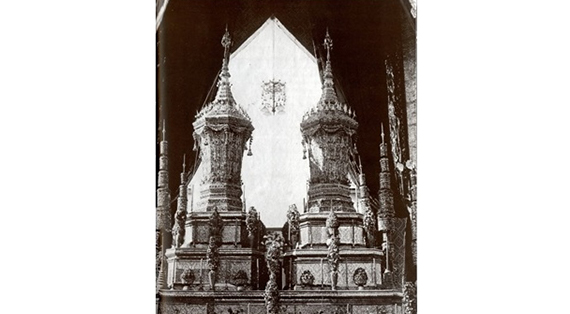
Urns for Princess Sudaratana Ratchaprayoon and Prince Chaturon Rasmi standing on two-step stands decorated with colour glass in the royal funeral hall
Commemorative Coins on the Occasion of the Royal Funeral in the year 119 of the Rattanakosin Era
King Chulachomklao commissioned coins to be made in commemoration of the royal funeral of five members of the royal family. These coins are named Mint Coins in Commemoration of the Royal Pyre Ceremony in the Royal Grounds of year 119 in the Rattanakosin Era. The coins are flat, round-shaped, with a smooth brim and measure 34 millimetres in diameter.
The front of the coins has the image of five-tiered and three-tiered umbrellas, with a decorative Kanok pattern. Under the umbrella is written the Royal Pyre Ceremony at the Royal Ground 119.
The back of the coins has royal symbols of each of the royal family members, placed on a decorative Kanok pattern, including:
1. Top left is a symbol of a coronet decorated with a feather which is the personal symbol of the Crown Prince Maha Vajirunhis.
2. Centre is a three-topped Prasat which is the personal symbol of Princess Sudaratana Ratchaprayoon.
3. Top right is a symbol of a winged-headpiece over a Chakra which is the personal symbol of Prince Chaturonrasmi.
4. Lower left is a symbol of a crown over the radiating sun which is the personal symbol of Prince Sommutiwongse Warothai.
5. Lower right is a symbol of a headpiece over a flower which is a personal symbol of Princess Siraphon Sophon.
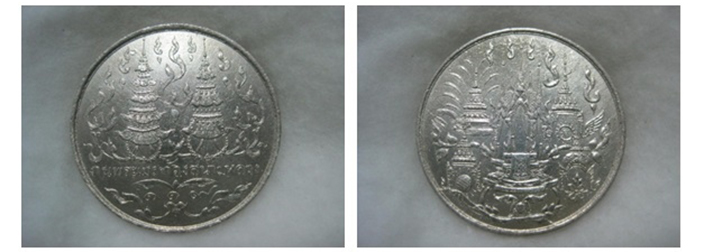
Silver Coin to Commemorate the Royal Pyre Ceremony in the Royal Grounds in the year 119 in of the Rattanakosin Era
It can be seen that the royal funeral in the Royal Grounds or Sanam Luang in 1900 was arranged according to royal traditions which had been passed on from the Ayutthaya period. It was considered as a way to pay the utmost respect to the Kings and the members of the royal family as if they were deities. The practice is carried out according to an Indian influence that Thai culture received through religions such as Brahmin and Buddhism. Brahmin, in particular, holds that Kings are the reincarnation of Shiva and Vishnu who came to rule and keep order among men. On the other hand, Buddhism believes in the idea of the three-tiered world or Traiphum which has Mount Meru as the centre of the cosmos. Mount Meru, a great mountain is surrounded by layers of mountains and oceans, a place of residence for the God Indra. In addition, according the to the Dharmasastra book of Mon culture, Kings are believed to be the head of state who hold the ten codes of virtuous ruling, and also have accumulated virtues.
Therefore, behaviour towards them should be according to the tradition, in order to express respect, love, and reverence to the Kings and honour the royal in an extraordinary way. In this vein, the architecture that is relevant to Kings, such as the royal palace and royal cremation pyres must represent greatness and extraordinariness to show the difference between that of the royal kind and the common people.
It can be said that the royal funeral in the Royal Grounds in 1900 reflect the importance of royal ceremonies which not only have been continued for a very long time but also strictly preserved. The preservation of such ceremonies shows respect and reverence towards the royal institution. Even after death, the members of the royal family are to be revered just as when they were alive. This could be seen at royal funerals held in the Royal Grounds, as well as the commission of the commemorative coins in memory of the royal funerals in the year 119. The coins, additionally, serve also as a record of such historic events of Thailand as well.
Translated from
Nattakarn Jantayod. (2015). Mint Coins in Commemoration of the Royal Pyre Ceremony at the Royal Ground in the year 119 of the Rattanakosin Era. (Thai version) Retrieved September 14, 2015, from Pavilion of Regalia, Royal Decorations and Coins e-museum: http://emuseum.treasury.go.th
